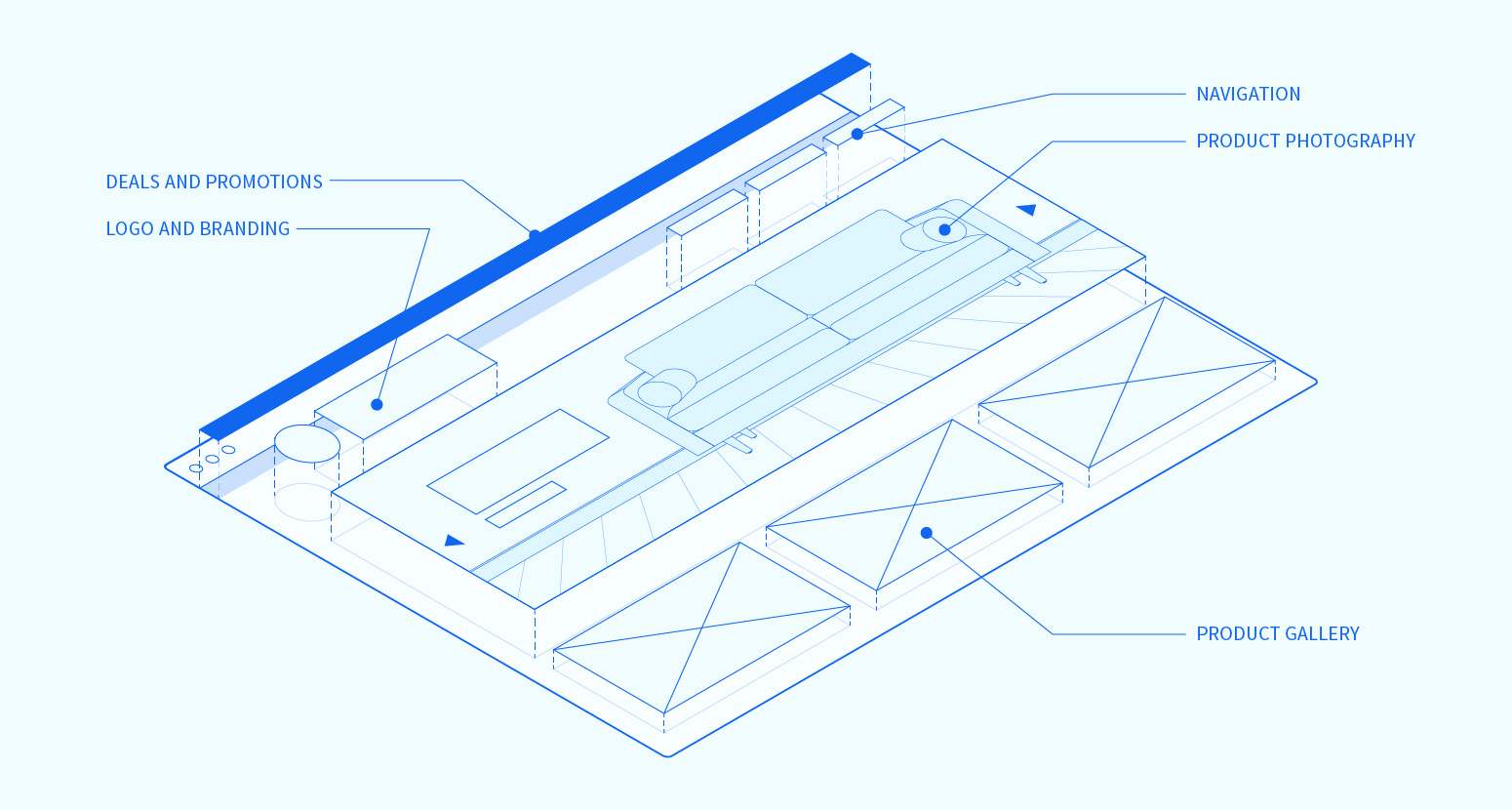Partnership is in the Gauge DNA. From our start in 2007, healthy human relationships have been at the heart of who we are and what we do. We’ve learned that there’s tremendous power in long-term partnerships. This is especially true in eCommerce where every aspect of a business, from apps to team members, are interconnected and interdependent.
The success of any eCommerce brand ultimately hinges on the health of its partnerships. Today we’ll cover why partnership is so important, and we’ll share some of the fundamentals of great partnership we’ve learned along the way.
The Good Kind of Spider Web
Healthy human relationships aren’t just a nice-to-have; they form the very foundation for business success. Big words, I know, but it’s easy to understand if you think of a business as a spider web of interconnected relationships.
A typical eCommerce website project is a complex web with many strands:
- The eCommerce merchant
- A digital agency
- A web platform
- A hosting entity
- A content management system
- An email marketing platform
- A payment processing service
- A shipping service
- Social media channels
- Accounting software
- Any number of apps and extensions
Our team functions the same way. Gauge’s spider web includes:
- Client team members
- Client stakeholders
- A Sales specialist
- A Project or Account Manager
- Designers
- Copywriters
- Developers
- Accounting representatives (ours and our client’s)
- Platform representatives
- Each client’s tech partners (hosting, marketing, accounting, apps/extensions, etc.)
Weaving all of these strands together requires coordination and teamwork. Each component has its own team or representative. Each person’s role is vital, because their work is interdependent. Very often, one team member’s success hangs on the work of others. Breakage at any point can ripple across the greater team effort, damaging timelines, ruining budgets, or even ending the project completely.
The success of the effort hinges on teamwork, and successful teamwork hinges on a group of people. Wonderfully complicated humans, each with their own foibles, strengths, goals, and emotions. All of these people must be united in strong partnerships to keep the whole effort from becoming a sticky mess.
So how can you build those partnerships? By focusing on four fundamentals:
- Mutual Respect
- Common Purpose
- Aligned Expectations
- Shared Trust
Fundamental 1: Mutual Respect
In the wise words of Queen Aretha: R-E-S-P-E-C-T, take care, TCB! Respect is the basic of all basics. No relationship or project can survive without it. And it’s far easier to maintain than to regain once it’s been lost.
In business, respect is perhaps the most important part of communication. It has two important elements: acknowledging value and embracing empathy.
Acknowledging value means recognizing that each person on your team shares responsibility for its success and brings an irreplaceable perspective to the team. Maybe she offers technical knowledge of a third-party service. Maybe he brings fresh ideas with his innate creativity. Seeing each person as equal and valuable promotes mutual respect.
Key to Acknowledging Value: Keep communication lateral. Treat every team member of every project as a peer. “Do as I say” communication reduces intelligent, creative people into cogs in an unfeeling machine. Once communication takes on a top-down tone, all bets are off.
Embracing empathy simply means seeing from another person’s perspective. Great communication takes practice, especially during high-stress moments. When faced with a difficult situation or conflict, it’s important to slow down, calm your emotions, and try to see from the other person’s perspective. Chances are, they’re feeling the stress too.
Key to Embracing Empathy: Be willing to apologize when you mess up, even if your intentions were good. Charles M. Blow once said, “One doesn’t have to operate with great malice to do great harm. The absence of empathy and understanding are sufficient.” We’ve all stepped on someone else’s toes. Nothing says “I understand and respect your point of view” like apologizing when the need arises.
Fundamental 2: Common Purpose
A shared vision is a compelling unifier—but that vision has to be more than profit. Sure, we all have bills to pay. But if you’re motivated purely by those dolla’ dolla’ bills, your team and business will suffer.
The eCommerce industry can be lucrative, but it’s hard. The day-to-day work can be mind-bending and tedious. You need passion, patience, creativity, and a rock-solid work ethic to survive.
That’s why it’s vital to know your greater vision. Understand the why behind your project and keep that top of mind for your team. A successful eCommerce site might deliver lifesaving information, host a like-minded community, inspire the creativity of children, or make thousands of people laugh. Whatever your greater goal is, keep that in the forefront.
Key to Common Purpose: Resist the temptation to reduce your project to dollars and bottom lines. This is easy to do, especially in the early stages. Site projects often require a big up-front investment, with big scary numbers. It’s tempting to squash your timeline or strip out requirements to save money. But doing that can stress out your team, create more work, increase technical debt, and ultimately cost you more in the long run.
Remember, eCommerce snowballs. Uniting your team with a shared vision keeps you moving during the slow early stages. If the strategy and commitment are in place and the vision is kept holy, the business of eCommerce almost always pays off.
Fundamental 3: Aligned Expectations
Ben Franklin said, “Love thy neighbor, yet don’t pull down your hedge.” Robert Frost put it another way, “Good fences make good neighbors.” Planks or topiary, the principal is the same: Boundaries are healthy.
This applies to eCommerce projects too. Decrease stress and increase accountability by setting clear expectations from Day One. Make sure all team members have a complete understanding of the project details. Document these before you begin and share them with everyone. Pay close attention to four areas: Timeline & Timeline Flexibility, Objectives, Scope, and Roles.
- Timeline & Timeline Flexibility: Setting the right timeline is a balancing act. Strict, absolute timelines can cause unnecessary stress. Too much flexibility can lead to waste and a loss of urgency. Careful timeline management must be understood, accepted, and practiced by all team members.
- Objectives: Project objectives must be clear and team members must keep these objectives top of mind. If objectives change, all team members must understand the change and its reasons.
- Scope: Lack of clarity here can lead to change orders, budget overruns, and a whole lot of tension. A simple rule of thumb: Don’t assume. Project stakeholders should treat the project documents as law. If it’s not in writing, it should be considered out of scope.
- Roles: Defining who will do what is a vital part of any team effort. Avoid stepped-on toes and gaps in work by clearly establishing and communicating roles. This will eliminate re-work, keep everyone working together, and prevent finger-pointing.
Fundamental 4: Trust
This one is the biggie; all healthy partnerships are built on trust. Trust in your partners is essential, yet it’s the hardest fundamental to define and maintain. Everyone has their own idea about what trust is and how it’s earned. To some it’s a gut feeling; for others, it’s earned through credentials and experience.
But there’s good news! When the other fundamentals are in place, trust will grow organically. If you maintain respect, common purpose, and clear expectations, you create an atmosphere where people can communicate, understand each other, and overcome challenges together.
The Online Etymology Dictionary describes trust with these phrases: “confident expectation,” “that on which one relies,” and “to make strong and safe.” Sounds like the ideal team environment in a nutshell!
Bottom Line
In any tech industry, it’s easy to get caught up in the whats—the best ERP, the right platform, the smartest marketing tools. Those are important decisions, and they’re worth time and effort.
Yet when eCommerce projects or brands fail, it’s not because someone picked the wrong technology. It’s because decision-makers failed to focus on the whos—their customers, their team members, their technology partners, or sometimes even themselves. People couldn’t communicate, or stress overran empathy, or expectations were out of whack, and ultimately, that all-important trust was lost.
Building healthy partnerships isn’t easy. It takes practice, humility, communication, and patience. But there’s no way around it—your business depends on your partnerships. If you could use a guide with both technical expertise and experience building healthy long-term partnerships, reach out to our team. Let’s build something together.
Adi serves as the Director of Solution Architecture at Shero, where his expertise in quality assurance and platform-specific knowledge greatly contributes to the successful launch of extensive eCommerce projects.
Known for his innovation and inquisitive nature, Adi is passionate about developing software and crafting eCommerce and digital strategies for our clients. In his role, he continually engages with the latest technologies, ensuring our clients and our team are poised for success.





